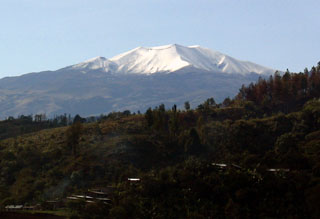Report on Purace (Colombia) — 22 May-28 May 2024
Smithsonian Institution / US Geological Survey
Weekly Volcanic Activity Report, 22 May-28 May 2024
Managing Editor: Sally Sennert.
Please cite this report as:
Global Volcanism Program, 2024. Report on Purace (Colombia) (Sennert, S, ed.). Weekly Volcanic Activity Report, 22 May-28 May 2024. Smithsonian Institution and US Geological Survey.
Purace
Colombia
2.3095°N, 76.3948°W; summit elev. 4650 m
All times are local (unless otherwise noted)
Observatorio Vulcanológico y Sismológico de Popayán, Servicio Geologico Colombiano (SGC) reported that seismic activity at Puracé decreased during 21-24 May and continued to be at pre-29 April levels. Both volcanic tremor (VT) associated with rock fracturing and long-period (LP) events associated with fluid movement were located less than 2.5 km beneath Puracé crater and had low magnitudes. Gas emissions from the crater and the N flank fumarole were occasionally visible in webcam views. Both the number and magnitude of LP events increased during 24-25 May. The events may have been associated with gas emissions with minor amounts of ash, but weather conditions prevented visual confirmation. Later that afternoon gas emissions from the crater and the fumaroles on the upper N flank were visible in webcam images. During 25-26 May LP events decreased in both number and size and seismicity associated with rock fracturing slightly increased. The earthquakes were located at depths of less then 3 km. LP seismicity was at stable levels and VT seismicity slightly decreased during 26-27 May, and both types of seismicity decreased during 27-28 May; events were located at depths less than 2 km. Gas emissions were observed in webcam views. Both carbon dioxide and sulfur dioxide emissions remained above baseline levels during the week. The Alert Level remained at Orange (the second highest level on a four-color scale).
Geological Summary. Puracé is an active andesitic volcano with a 600-m-diameter summit crater at the NW end of the Los Coconucos Volcanic Chain. This volcanic complex includes nine composite and five monogenetic volcanoes, extending from the Puracé crater more than 6 km SE to the summit of Pan de Azúcar stratovolcano. The dacitic massif which the complex is built on extends about 13 km NW-SE and 10 km NE-SW. Frequent small to moderate explosive eruptions reported since 1816 CE have modified the morphology of the summit crater, with the largest eruptions in 1849, 1869, and 1885.

